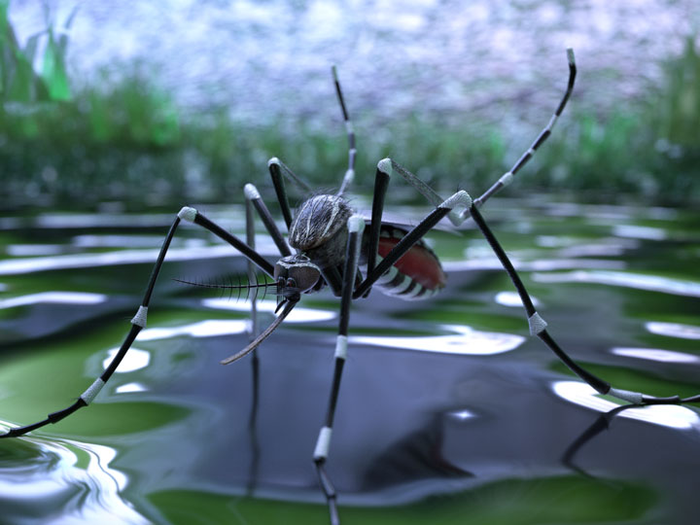Gene editing could render mosquitos infertile, reducing disease spread
New U.S. Army-funded research uses gene editing to render certain male mosquitoes infertile and slow the spread of these diseases.

[August 23, 2021: U.S. Army Research Labratory]
New U.S. Army-funded research uses gene editing to render certain male mosquitoes infertile and slow the spread of diseases like Zika and yellow fever. (Credit: University of California Santa Barbara)
Mosquitos spread viruses that cause potentially deadly diseases such as Zika, dengue fever and yellow fever. New U.S. Army-funded research uses gene editing to render certain male mosquitoes infertile and slow the spread of these diseases.
Researchers at the Army’s Institute for Collaborative Biotechnologies and the University of California Santa Barbara used a gene editing tool known as CRISPR-Cas9 to target a specific gene tied to fertility in male mosquitoes. CRISPR-Cas9 is a genome editing tool that is creating a buzz in the science world, according to yourgenome.org. It is “faster, cheaper and more accurate than previous techniques of editing DNA and has a wide range of potential applications.”
Researchers experimented with the Aedes aegypti mosquitoes, which are found in tropical, subtropical and temperate regions throughout the world. The study, published in the Proceedings of the National Academy of Sciences, discerned how a mutation can suppress the fertility of female mosquitoes.
“This is yet one more important and exciting example of how synthetic biology tools are demonstrating unparalleled utility,” said Dr. James Burgess, ICB program manager for the U.S. Army Combat Capabilities Development Command, now known as DEVCOM, Army Research Laboratory. “In this case, it’s a precision increase from chainsaw to a scalpel leading to the correct biochemical outcome that could substantially reduce the population of a very infectious mosquito.”
To manage populations, scientists use a vector-control practice called the sterile insect technique in which they raise a lot of sterile male insects and they then release these males in numbers that overwhelm their wild counterparts. Females that mate with sterile males before finding a fertile one are themselves rendered infertile, thereby decreasing the size of the next generation.
Repeating this technique several times has the potential to crash the population because each generation is smaller than the last; releasing a similar number of sterile males has a stronger effect over time.
The sterile insect technique is effective in managing a number of agricultural pests, including the Mediterranean fruit fly, a crop pest in California. It has also been attempted with Aedes aegypti mosquitoes, but with limited success.
In the past, scientists used chemicals or radiation to sterilize male Aedes aegypti, but the chemicals or radiation impacted the mosquitos’ health to such an extent that they were less successful in mating with females, which undercuts the effectiveness of the sterile insect technique.
The research team wanted to identify a more targeted approach with less collateral damage, mutating a gene in mosquitoes that specifically caused male sterility without otherwise impacting the insects’ health.
“When CRISPR/Cas9 came out several years ago it just offered new opportunities to do things that you couldn’t do before,” said Dr. Craig Montell, distinguished professor at UC Santa Barbara. “So, the time seemed right to for us to start working on Aedes aegypti.”
Using gene editing in male Aedes aegypti, researchers found that the mutant male mosquitos produced no sperm, and unlike in previous efforts, the sterile studs were otherwise completely healthy; however, the team wasn’t sure whether sperm, albeit defective sperm from the sterile males, was needed to render female mosquitoes infertile, or whether the transfer of seminal fluid was all it took.
In one experiment, researchers introduced 15 mutant males into a group of 15 females for 24 hours. Then they swapped the males for 15 wild-type males, and left them there.
“Essentially, all of the females remained sterile,” Montell said. “This confirmed that males could suppress female fertility without producing sperm.”
Next the researchers set out to determine how timing played into the effect. They exposed the females to mutant males for different lengths of time. The scientists noticed little difference after 30 minutes, but female fertility quickly dropped after that. Montell noted that females copulated twice on average, even during the first 10 minutes. This indicated that females have to mate with many sterile males before being rendered infertile themselves.
Combining the females with the males for four hours cut female fertility to 20% of normal levels. After eight hours the numbers began leveling out around 10%.
According to Montell, Aedes aegypti populations could easily bounce back from an 80% drop in fertility. The success of sterile insect technique comes from subsequent, successive releases of sterile males, where each release will be more effective than the last as sterile males account for an ever-growing proportion of the population.
The team plans to continue investigating mosquito mating behaviors and fertility. They are devising a way to maintain stocks of males so they are only sterile in the wild and not in the lab. In addition, they are characterizing male mating behavior to uncover new ways to suppress mosquito populations.
“We’ve become very interested in studying many aspects of behavior in Aedes aegypti because these mosquitoes impact the health of so many people,” Montell said. “There is a pandemic every year from mosquito-borne diseases.”
The ICB is an Army-sponsored University Affiliated Research Center led by the University of California, Santa Barbara, in collaboration with the Massachusetts Institute of Technology, the California Institute of Technology and partners from the Army and industry. Interdisciplinary teams of biologists, chemists, physicists, psychologists, physicians and engineers develop biologically inspired, revolutionary technological innovations in systems and synthetic biology, bio-enabled materials and cognitive neuroscience.
Like these kind of feel good stories? Get the Brighter Side of News' newsletter.
Tags: #New_Discoveries, #Insects, #Fertility, #Gene_Editing, #Research, #CRISPR, #Arthritis, #The_Brighter_Side_of_News
Joshua Shavit
Science & Technology Writer | AI and Robotics Reporter
Joshua Shavit is a Los Angeles-based science and technology writer with a passion for exploring the breakthroughs shaping the future. As a contributor to The Brighter Side of News, he focuses on positive and transformative advancements in AI, technology, physics, engineering, robotics and space science. Joshua is currently working towards a Bachelor of Science in Business Administration at the University of California, Berkeley. He combines his academic background with a talent for storytelling, making complex scientific discoveries engaging and accessible. His work highlights the innovators behind the ideas, bringing readers closer to the people driving progress.



